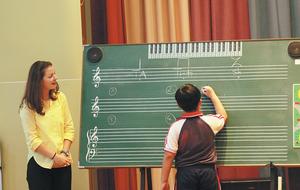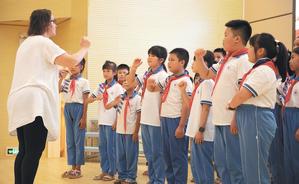Teaching music takes on a different approach as the Kodaly method is utilized, hitting the right note with children in poverty-stricken regions who give it a chorus of approval, Wang Kaihao reports.
 Edit Lanczky, a music teacher with the Beijing Hungarian Cultural Institute, trains local teachers in a workshop in Chenzhou, Hunan province, in September 2019. (PHOTO PROVIDED TO CHINA DAILY)
Edit Lanczky, a music teacher with the Beijing Hungarian Cultural Institute, trains local teachers in a workshop in Chenzhou, Hunan province, in September 2019. (PHOTO PROVIDED TO CHINA DAILY)
Children. Circle. Warmup exercises. This is not physical education, nor the prelude to a demanding workout. This is a music class. Though not as you know it, children shake their bodies and clap looking for the right rhythm. Unconventional? Perhaps. Successful? Yes.
Specifically, this is the Kodaly method. It stems from Hungarian composer Zoltan Kodaly (1882-1967). In August, a group of children in Anren county, Chenzhou, Hunan province, gave it a try.
The children are very disciplined and passionate, but I want to prove to them that chorus is not only about good discipline. It can be full of fun
Edit Lanczky, music teacher with the Beijing Hungarian Cultural Institute who instructs teachers and students in the Kodaly method
Edit Lanczky, a music teacher with the Beijing Hungarian Cultural Institute, came to China last year. She and her colleagues, including Nora Guncz, have a romantic nickname to introduce that methodology around China: "Backpackers of music".
In Anren she rehearsed daily with a chorus of primary school students.
"I'm excited to join the mission of taking part in the education of children from poverty-hit regions," Lanczky recalls in an exclusive interview with China Daily.
"The children are very disciplined and passionate, but I want to prove to them that chorus is not only about good discipline. It can be full of fun."
The Kodaly method is known for its inspirational approach to developing children's musical talent and getting them to express it through games and body movements, rather than spoon-feeding them complicated theories.
It became the dominating music methodology in Hungary after World War II. The method was inscribed on the UNESCO Intangible Cultural Heritage list in 2016.
Anren county, where the economy relies on agriculture, got rid of the title of "national-level impoverished county" just last year. Like many other such regions, where people are still struggling to improve their livelihood, music education seems like an unaffordable luxury.
Thanks to Beijing Deqing Foundation, a charity group devoted to improving education in poverty-stricken areas, 14 counties in Hubei and Hunan provinces have benefited from a music program since 2015.Chorus groups have mushroomed in these places under the sponsorship of the foundation.
Nevertheless, some facilities and musical instruments, like the piano, still seem out of reach for every school. However, after the Beijing Hungarian Cultural Institute joined the program in 2017, the Kodaly method offered alternatives.
According to Lanczky, in Kodaly's time, pianos were not commonly available to Hungarian families. Consequently, a cappella-singing without instrumental accompaniment-was utilized. Many ancient Hungarian ballads were passed down through generations, unaccompanied by music.
"For children, the vocalized sound is natural, but using musical instruments isn't," she explains. "That's why the Kodaly method isn't restricted by spaces and conditions."
Wang Qiong, a primary school student from Anren, recalls: "I am really relaxed when I join in during Mrs Lanczky's class because I'm playing and learning. Sometimes, we have a role-playing game to get a better understanding of sound. It is interesting to set my imagination free. I once played the part of a 'mountain'."
 Nora Guncz, a music teacher from the Beijing Hungarian Cultural Institute, instructs a local student in music by applying the Kodaly method in the Jianghua Yao autonomous county of Yongzhou, Hunan province, in September 2018. (PHOTO PROVIDED TO CHINA DAILY)
Nora Guncz, a music teacher from the Beijing Hungarian Cultural Institute, instructs a local student in music by applying the Kodaly method in the Jianghua Yao autonomous county of Yongzhou, Hunan province, in September 2018. (PHOTO PROVIDED TO CHINA DAILY)
Handing down the skills
Hand signs are important in the Kodaly method. They function not only as a visual aid to accurately vocalize each tone, but also as a way to communicate between teachers and students.
"It's amazing to see that the (Hungarian) teachers never yell at students," Chen Chenxi, a local music teacher from Anren, says. "They don't need to. If there is any problem in rehearsals, students can also give feedback through their hand signs, so the method, with less talking, will preserve our vocal chords in the future."
Meanwhile, the emotional attachment formed between teachers and students in the warm, cozy environment during the rehearsal has proved to have strength and influence beyond the music room. For one thing, it seems conducive to improving students' communication skills.
"I used to be very timid," Pan Peiru, a student in the chorus, says. "But the teachers have helped me to have more confidence on stage, and with a common interest in singing, I have a lot more to share with my classmates."
"A choral group is like a miniature society, and the project can improve children's social competence," says Szonja Buslig, head of the Beijing Hungarian Cultural Institute, of her observation. "Inspired students can also do better in other classes."
In places like Anren, where many parents work in big cities, the children are often left behind to live with their grandparents. They sometimes retreat into themselves and become unsociable.
"In Hungary, joining a chorus is one of the few things children will feel most proud of," Buslig says. "I believe that it can also create more joyful moments for Chinese children, who will be proud of themselves."
It echoes how Li Kemei, director of Beijing Deqing Foundation, once explained her motive for launching the program. "The biggest gap in education between big cities and rural areas does not exist in English or math, but in fine art," she says. "And chorus can also develop an esprit de corps and harmony among different members, which will be beneficial throughout their lives."
Fine-tuning the process
Buslig also realizes that individual effort is, of itself, not enough. The project ushering the Kodaly method into the campaign against poverty needs more local seeders. As well as Hungarian "music backpackers "enlightening children, it seems an even more important task to nurture local teachers.
Since 2017, 850 teachers around China have been trained in the Kodaly method. Even during the COVID-19 outbreak in China earlier this year, the program continued through live online broadcasts.
 Lanczky rehearses with a chorus of primary school students in Anren county, Chenzhou of Hunan, last month. (PHOTO PROVIDED TO CHINA DAILY)
Lanczky rehearses with a chorus of primary school students in Anren county, Chenzhou of Hunan, last month. (PHOTO PROVIDED TO CHINA DAILY)
Huang Wenjuan, a math teacher from the rural area of Jianghua Yao autonomous county in Hunan, took part in the online program from March to June. The primary school she works at does not have a fulltime music teacher. She underwent training and took responsibility to teach her students to sing in chorus, because singing is also her hobby.
"I'm not that professional a singer," Huang tells China Daily. "And the music class used to be a case of me singing a line first and then having the students sing it back. I found many children were out of tune, but I didn't have a good way to correct them.
"However, with the hand signs and Kodaly method's other approaches, it works more easily," she says, while recalling with excitement her first tentative classes using the method with third grade students.
"The students who mastered the method can also practice vocalizing the standard tune at home without mimicking me," Huang says.
"We are also encouraged to take into account the individual needs and abilities of each student, rather than applying a single format to all."
Huang now regularly sends the video clips of her music classes back to the teachers at the Beijing Hungarian Culture Institute for follow-up evaluation.
"I also make time to impart some basic principles of the Kodaly method to other teachers I know," Huang continues. "I hope that one day all students in Jianghua can learn music in such a happy way."
Cultural resonance
Promotion of the Kodaly method in China is not "one-way", as Buslig points out. "Cultural communication is a process of mutual learning," she says. "We can also gain new inspiration from the program."
This emotional resonance has a historical foundation. Magyars, the main ethnic group of Hungary, are widely believed to have come from the East.
Ancient Hungarian folk songs, those from before the 18th century, were composed using the pentatonic scale (five notes per octave), according to Lanczky, and the scale is the one primarily used in the Kodaly method to educate children.
Ancient Chinese music also traditionally adopts a pentatonic structure.
In the past year, Lanczky has traveled around China collecting many Chinese ballads from Inner Mongolia, Sichuan, Guizhou and other provinces and autonomous regions.
"The Kodaly method has been a good way to preserve traditional Hungarian folk songs, which are usually duets," she says. "And Chinese folk songs, which have a more complicated structure, can enrich its contents."
She and her colleagues are now drafting the first textbook of the Kodaly method specifically for China. Whenever she delivers classes, she asks local teachers like Huang to collect as many traditional local songs as possible for future textbooks.
On the final day of class in Anren, a chorus of local children presented Bodzavirag, a Hungarian household folk song. Like their angelic voices, the faculty's passion for the art also seems to be soaring.
Contact the writer at wangkaihao@chinadaily.com.cn


